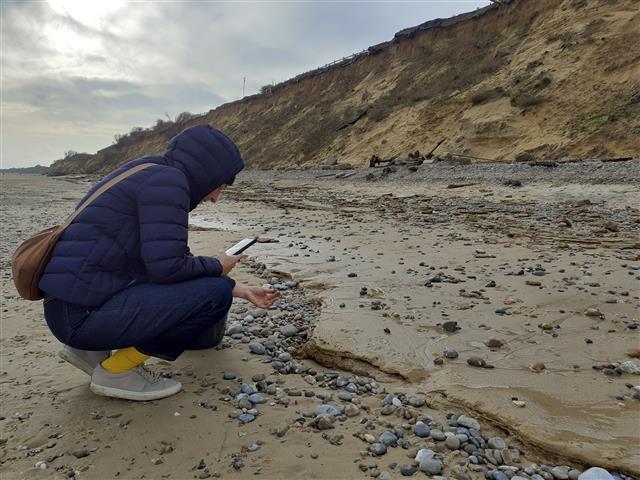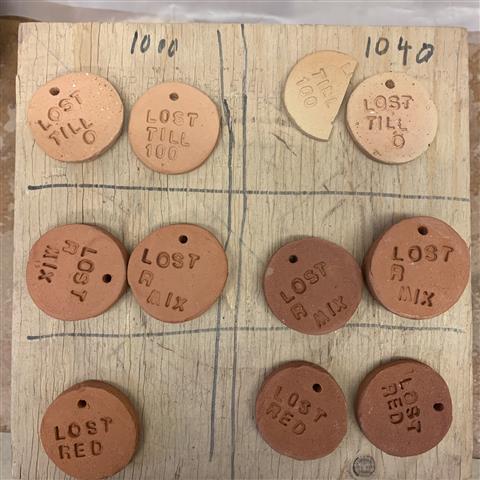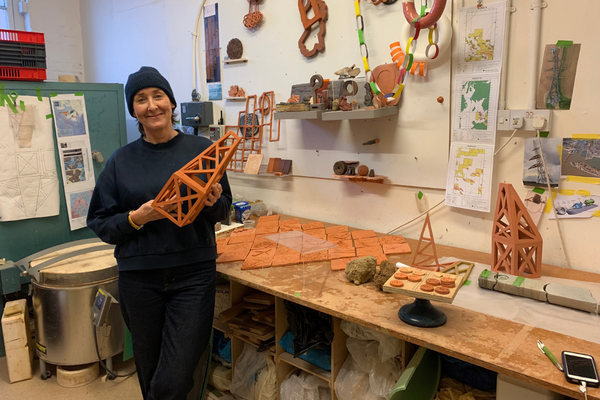Alison Cooke is an artist who digs deep to tell stories about the land. Here she shares her experience of her North Sea residency and working with local communities.
“I’m a ceramic artist who works with clay unearthed from sites of historic or geological interest. I’m interested in where the materials I work with come from, the layers of history below a location and where those histories overlap or impact our lives today."
"I have an ongoing interest in the North Sea, its rise and fall, the eroding coastline, and our ancestors who lived on what is now the sea bed and how they (and we) respond to the challenge of rising sea levels".
Lowestoft
For the residency I chose to work in Lowestoft, a town on the North Sea coast that previously had a large herring fishing industry. In the 18th century it produced ceramics; now it is a base for the renewable energy industry. The coastline around Lowestoft is eroding at a fast pace and will be greatly impacted by rising sea levels due to climate change; the transition from fossil fuels to renewables is all the more relevant for the locals. On a previous visit before my residency, the harbour was lined with row upon row of blades and wind turbine nacelles (the hubs containing components) - an amazing sight. On the residency, I have been able to see these structures in the North Sea spinning away, harnessing energy. For the residency I chose to explore the changing industry with the local community. I wanted to use locally dug clay for my own response and a project that involved 100 residents.
Studio and community
My studio was in the Woodwork Arts Cafe, a community hub, a cafe and place to learn craft, pottery, paint, draw and more. Run by Kinsey Foster, whose psychotherapy background has informed her strong belief that art and craft improves mental health. The cafe ran numerous classes and worked with various groups from drop-in sessions, to home schoolers to social referrals from the NHS, and Kinsey engaged young people excluded from school for work experience. It was a busy, noisy, happy, creative environment.
Digging clay
The first task was to get local clay. I walked with East Anglian geologist Martin Warren to the collapsing cliffs of nearby Pakefield and he talked me through the geology. There are two areas of clay in the cliff, a red seam in between thick layers of sand and high up the cliff is Lowestoft till. During the Anglian ice-age 450,000 years ago a vast glacier sat atop the UK, it held the frozen North Sea and the debris from the sea. The main edge of the glacier was at Cromer, in Norfolk, but fingers of ice stretched as far south as Lowestoft in Suffolk. As the planet warmed the glacier melted and released the debris held within it and formed a sediment layer of till. The till is only 30% clay, but this geological history is so relevant to the current climate crisis, so I picked it up from cliff falls. A couple of weeks later after quite a rough tide a whole seam of the red clay was exposed on the beach and easy to access.
Clay processing - some clays are pure and stone free and useable straight from the ground but this stuff was full of sand, chalk and flint. Processing it into workable clay involves several stages:.
1.Remove large stones, flints, chalk by hand.
2.Pour on water and leave to break down into a mud consistency.
3.Pour through a household sieve. The liquid that come through the sieve is clay.
4.Pour the liquid clay onto plaster batt to dry out. Roll it up and its ready.
Once processed I made discs of the two different coloured clays, and a mix of both and fired them at different temperatures.

Pakefield Beach, Lowestoft. A thick seam of red clay became exposed on the beach after a heavy storm
Earth Wind and Fired - Lowestoft tile project
I recruited locals from the many visitors at the Woodwork Arts Cafe and by advertising the activity around town with posters and leaflets: “Join us in free clay workshops, drawing into 100 clay tiles that celebrate how Lowestoft has harnessed the wind.” Lowestoft is world famous for it's heritage of herring caught by sailboats powered by the wind, now as a centre for sustainable energy from the wind.
Earth, Wind & Fired celebrates what Lowestoft has always done - harness the wind. The breeze that blew the fishing boats to their catch now turns the turbines to light our homes. I made diamond shaped tiles for the residents to work on. This motif/shape makes reference to the diamond shapes within fishing nets and to the new style pylons. Saturdays I did workshops at the cafe and during the week visitors to the cafe were encouraged to take part. The tiles could be displayed in a variety of ways, and together they form a net pattern. Within them I’m adding flat ceramic slabs that take the shape of wind farms off the East Anglia coast, the slabs marked with the placing of each turbine.

Test firing Lowestoft clay. Two clays from the same location but millennia apart. Fired individually and mixed together at 1000°c and 1040°c
I’m also using the Lowestoft clay to make elements from turbines, pylons and subsea cables (after a fascinating trip to the Nemo Link, (which connects the electricity network of Great Britain and Belgium). The work I make from the clay represents the future, renewables and the infrastructure needed to transmit energy. Alongside this I’ve obtained 30ft of rock core and boxes of rock cuttings that were removed from 4km below the seabed by an oil company in its exploration for fossil fuel. I am making work with these two of separate materials, the rock and the clay, representing the two different sources of energy, the old and the new, fossil fuels versus. clean energy, unsustainable versus. sustainable, finite versus renewable.
The workshops gave me the opportunity to talk to the residents about a whole range of topics: how local industry had changed; their awareness of Lowestoft being a base for renewable energy; how future climate change might affect the area; the decline of the fishing industry; stories they’d been told about relatives migrating up and down the coast following the herring; fisherman who hated fishing; and memories of mothers and grandmothers who made nets in their homes. In the tiles they carved images that ranged from boats, nets, fish, turbines, pylons, lightbulbs, some people made images that represented wind, others focused on texture or movement.
What came through strongly in every conversation was that they were proud of their town, its heritage, and had a positive outlook for its future.
The open framework and the accessibility of the cafe enabled me to capture a whole range of ideas from people who know and live in this area as it undergoes huge transformation. This sort of participation is crucial if we are to include people in what will be a radical shift in energy.
To see more of Alison's work visit: https://www.alisoncooke.co.uk and Instagram: alison.cooke

